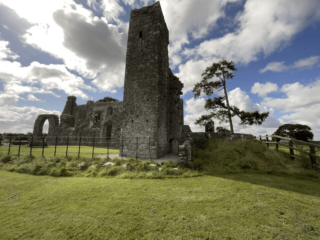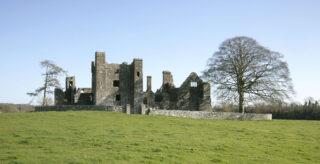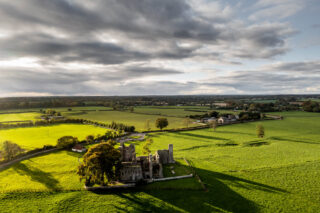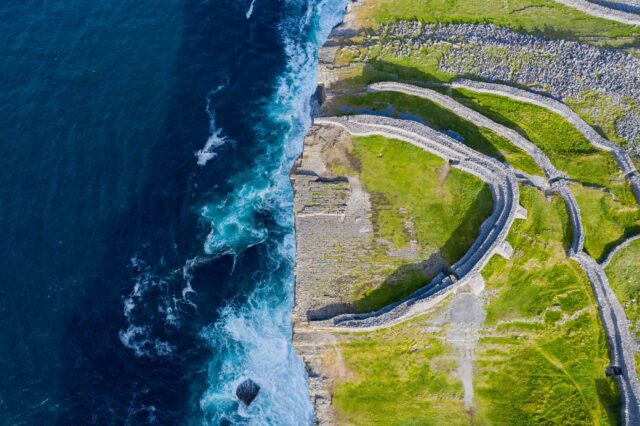Fógra
WARNING: It should be noted that these sites are unguided and a level of care and caution should be maintained during all stages of your visit. The Office Of Public Works (OPW) will not be held responsible for any damages, injuries, or losses that occur
Bective Cistercian Abbey
Bective Abbey is located on a high northern bank of the Boyne River, half way between Navan to the north, and Trim to the south west, and less that one kilometre (.62 of a mile) south east off the R161 from Connell’s Cross.
Under the invocation of the Blessed Virgin, and called the Abbatia de Beatitudine, from which it is thought that the name Bective is a corruption, it was founded in 1147AD for the Cistercian Order by Murchard O’Melaghlin, King of Meath. It is the only building erected for the Order in County Meath. Its mitred abbot was a Baron in the Parliament of the Pale. Nearby to the Abbey once stood Bective Castle, erected in 1014AD and believed to have been, apart from the country’s many Round Towers, one of the earliest stone buildings in Ireland. The locale gave the title of Earl of Bective to the Taylor family.
In 1186, Hugh de Lacy, Lord of Meath under King Henry II, was murdered by one of his workers while supervising the building of Durrow Abbey and his body was interred in that place. In 1195, he was disinterred and his decapitated body was buried in Bective Abbey, his head having otherwise been sent for burial to the Abbey of St. Thomas in Dublin. Following a prolonged dispute between the two abbeys for his body, he was disinterred from his resting place in Bective in 1205 and reburied in St Thomas's Abbey, in the tomb of his first wife.
Every year during its active life, Bective was visited by Continental scholars, minstrels and pilgrims. In the Abbey’s library were once deposited over five thousand manuscript volumes written in Greek, Latin, Hebrew and Spanish.
At the time of the Dissolution of the Monasteries, initiated by King Henry VIII of England in 1536, the demesne lands of Bective comprised of 245 acres. It was, during that period, described as consisting of "a church, hall, and cloister, with certain chambers and other buildings". On the 31st July 1542, the Abbey was surrendered to the Crown, after which time it was used as a fortified manor house. The remains of a large square crenelated tower, and beside it a Tudor residence with fine mullioned windows, show how the site evolved in the 16th century.
The property subsequently passed through the hands of a number of families, including those of Agard, Wyse and Dillon, eventually coming into the possession of the Boltons in about 1639 when it was granted to Sir Richard Bolton by Charles I, King of England. Sir Richard’s descendants held it for several centuries, until, in the 19th century, they built the nearby Bective House. In 1864, Richard Bolton expended a large sum of money clearing a mass of rubbish from the ruin and repaired the wall surrounding the abbey. He also placed a series of stone seats throughout the site for the use and enjoyment of visitors.
The Abbey was the Cistercian Order’s second settlement in Ireland, and was a daughter house to Mellifont Abbey in County Louth. The Order had been founded to reassert the simplicity of monastic life, a dedication that was reflected in the restrained design of their buildings. At its most active, Bective was an important monastic settlement, the remains now visible dating mainly from the 13th to the 15th centuries.
What is left to be seen from the 12th century are a few remnants of the nave’s south arcade, parts of the south transept, the chapter house and various domestic accommodations. Most beautiful is the well-preserved cloister with its cinque-foiled and decorated gothic arches, supported by clustered pillars and topped by fine capitals, all expertly hewn from hard Ardbraccan stone. Delicate carvings of foliage and a hawk-like bird still ornament several of the columns. On one can be seen an exquisitely fashioned depiction of Bernard of Clairvaux (1090-1153), the poet-saint co-founder of the Knights Templar, and a reformer, through the Cistercian Order, of the Benedictines.
Throughout the site, blocked up arches, windows and doors indicate the changing adaptation of and addition to the Abbey’s various buildings as they responded to the demands of each passing century. One of the most obvious missing elements on the site is the Abbey’s large church. Identifying its traditional east/west alignment, only the dilapidated bases of some of its north aisle’s arches are still evident.
In 1900, extensive repairs, and the removal of a large amount of destructive ivy, were carried out by the Commissioners of Public Works.
A large medieval barn, shedding important light on Irish rural monastic life and farming methods, was discovered during excavations led by Geraldine and Matthew Stout between 2009 and 2012.
Bective Abbey has been used as a major Hollywood film set three times. The first was in 1955 for 'Captain Lightfoot’ starring Rock Hudson, the second for the 1995 blockbuster 'Braveheart' starring Mel Gibson, and the third in 2020 by Ridley Scott for 'The Last Duel', starring Matt Damon, Adam Driver, Jodie Comer and Ben Affleck.
The hopes of Oscars aside, the website of the National Folklore Collection at www.duchas.ie archives a number of digitised stories regarding a bishop’s coffin made of pure gold as having been buried in the Abbey.
Visit Historic Environment Viewer and Monastic Ireland for more information on Bective Abbey
Protect our Past - Click here to read about the importance of protecting our country’s unique heritage sites
This national monument is protected in accordance with the National Monuments Acts 1930 to 2014
Gailearaí
Suíomhanna cóngarach
Teamhair
Faigh blaiseadh d’oidhreacht na n-ardríthe
Timpeall 6.0 km ón
Caisleán Bhaile Átha Troim
An siombal is mó le rá de chaithréim na Normannach
Timpeall 6.5 km ón
Ionad Cuairteoirí Bhrú na Bóinne: Sí an Bhrú, Cnóbha agus Dubhadh
Tabhair cuairt ar an tírdhreach seandálaíochta is saibhre in Éirinn
Timpeall 20.8 km ón
Caisleán Mhaigh Nuad
Spléachadh ar shaol i ndaingean Normannach
Timpeall 23.5 km ón
Láithreán Mainistreach Chistéirseach na Seanmhainistreach Móire
Tabhair cuairt ar an gcéad áit a bhunaigh na Cistéirsigh in Éirinn
Timpeall 23.7 km ón
Ionad Cuairteoirí Chath na Bóinne – Eastát an tSeandroichid
Áit ar throid beirt ríthe ar mhaithe le todhchaí na hEorpa
Timpeall 24.4 km ón






